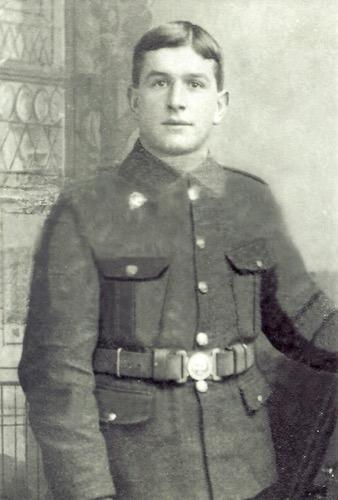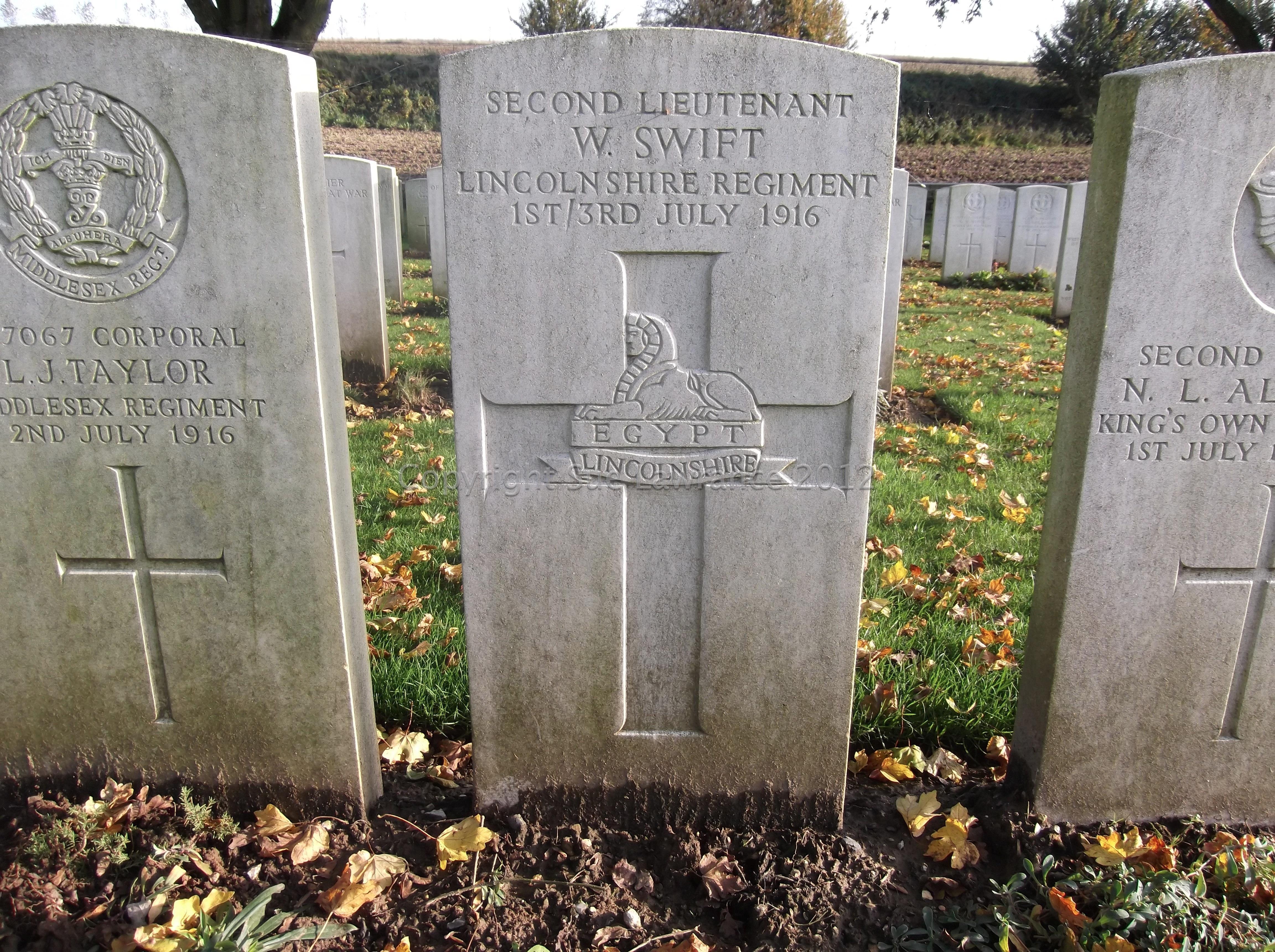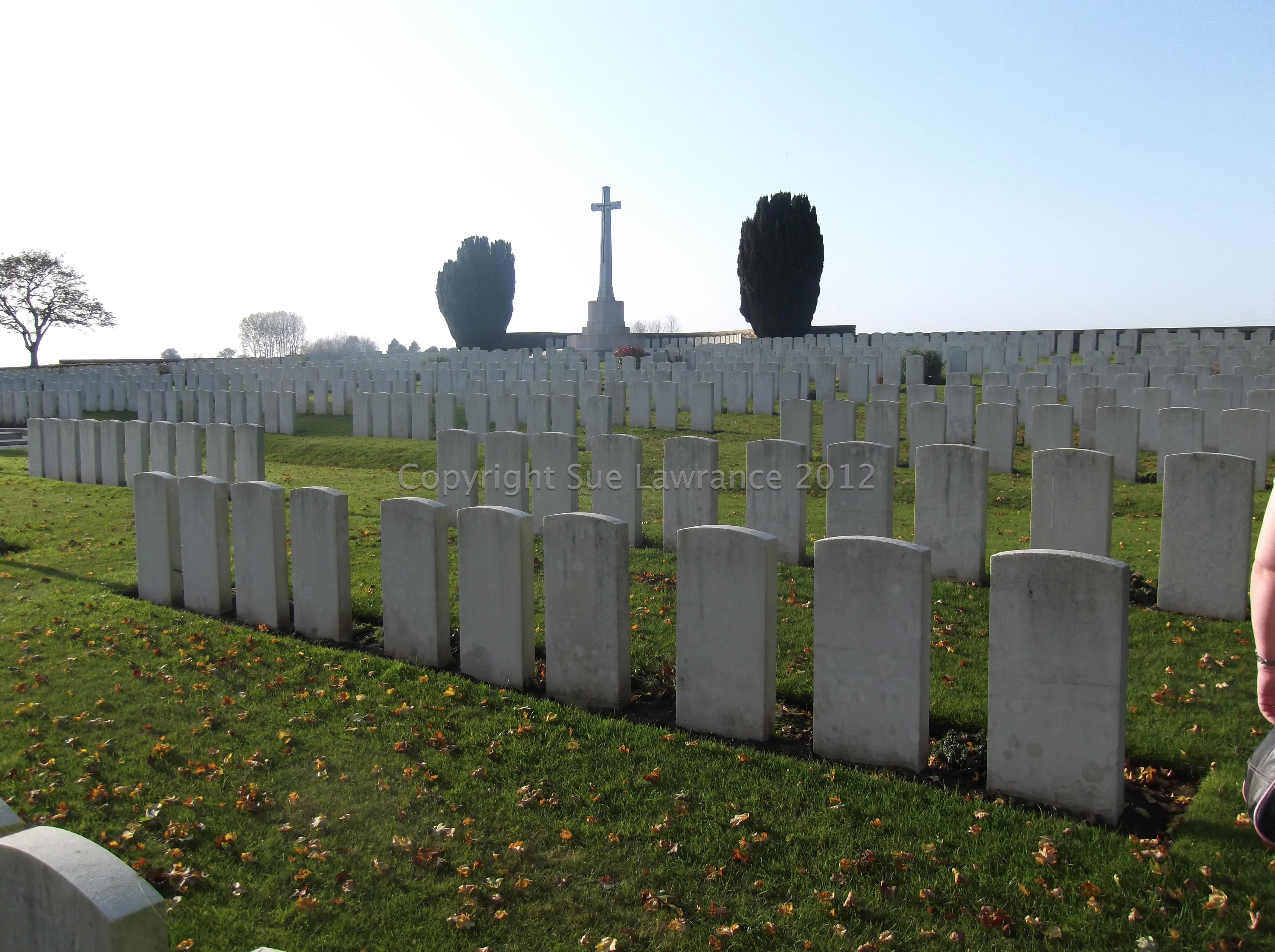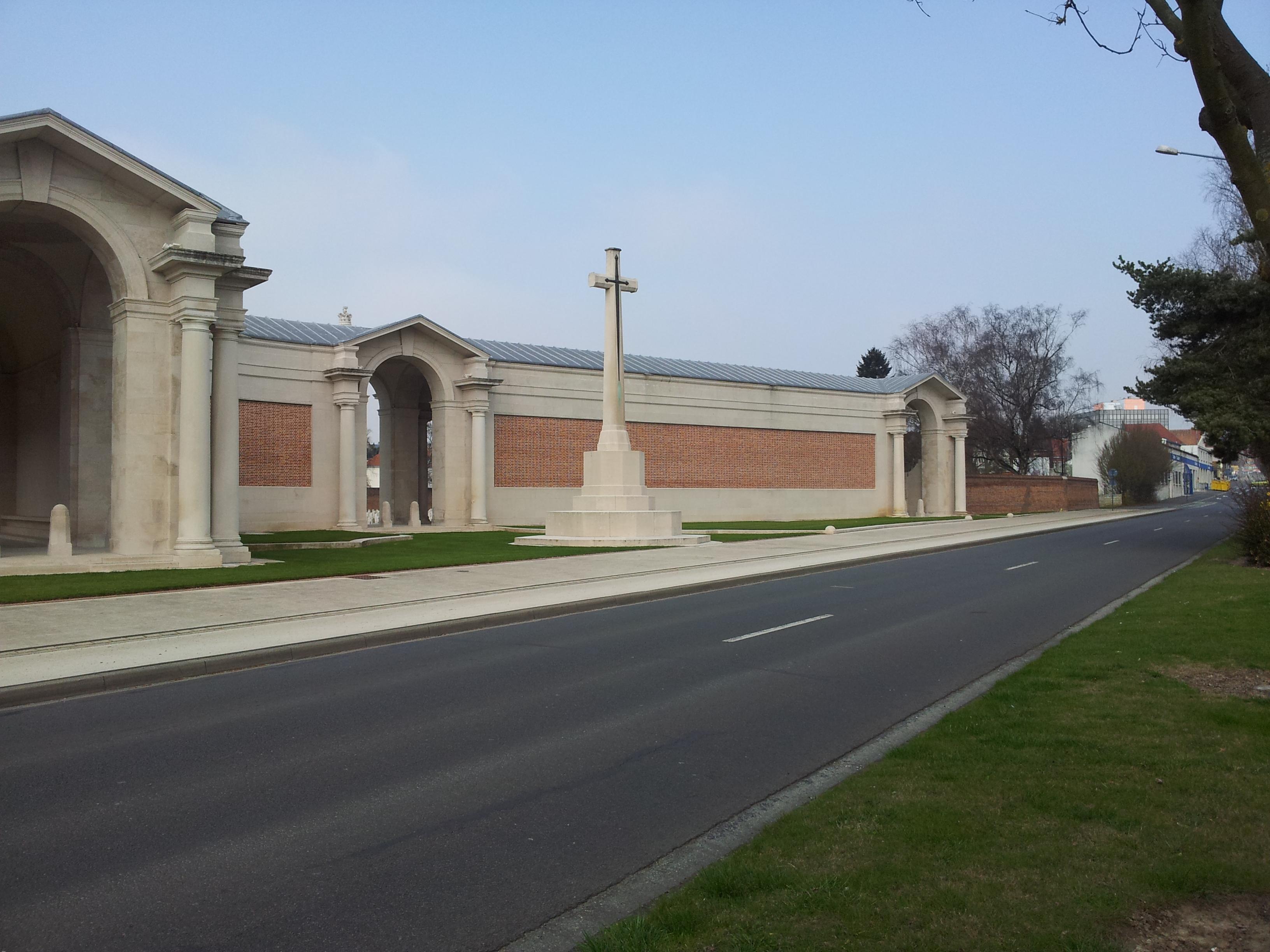Remembrance – Ralph Pattison

Yesterday we remembered local Bourne man Lance-Corporal Ralph Pattison who was killed in action on this day, 3rd July 1916, serving with the 1st Battalion Lincolnshire Regiment at the Battle of the Somme.
Ralph was born in 1883 to Richard Newton Pattison a tailor for 40 years of Eastgate Bourne and his wife Fanny, nee Kettle.
Richard Newton Pattison was born in Redbourne, Lincolnshire in 1845 and although a master tailor has served 10 years with the 10th (North Lincoln) Regiment of Foot being discharged in August 1871, after seeing service across the world. including time in Yokohama, Japan.
Richard Pattison settled in Bourne after his discharge and married Fanny Kettle of Bourne in 1878. Fanny was born in Bourne in 1857 although currently her parents are not known to us.
A year later their first child, Richard Newton Pattison was born in Bourne and the couple went on to have 14 children including one set of twin girls. The children were:-
• Richard Newton Pattison, 1879, Bourne (Royal Flying
Corps)
• John Pattison, 1880, Bourne
• Alice Annie Pattison, 1882, Derby
• Ralph Pattison, 1883, Bourne – (1st Lincs)
• Frank Pattison, 1884, Bourne – (Australian Colonial
Force)
• Stephen Pattison, 1886, Bourne – (farrier Sergeant)
• Fanny Pattison, 1888, Bourne
• Arthur Pattison, 1890, Bourne
• May Pattison, 1891, Bourne (Twin)
• Rosamond Pattison, 1891, Bourne (Twin)
• Harry Pattison, 1893, Bourne (Bugler 3/4th Lincs)
• Elizabeth Mary Pattison, 1895, Bourne
• Charlie Pattison, 1897, Bourne (Northants Field
Artillery)
• Emma Pattison, 1900, Bourne
In 1891 Ralph can be found living with his parents and siblings in Eastgate Bourne. At the time Richard was a Tailor being employed. John, Alice, Ralph and Frank were all listed as scholars with youngest son Stephen aged 4.
Ten years later the census of 1901 shows that the family now lived on Willoughby Road and by now Richard is a Master Tailor working at home on his own account. Robert (sic, Richard) was working as a journeyman tailor, Ralph now 17, was working as a Maltster’s Labourer and Frank as a wheelwright. Stephen, May, Rosamund, Harry, Charlie and 4 month old Emma was still in the household.
Ralph, married Florence Rimmington in 1904, she was born on 1st August 1884 in Grantham Lincolnshire.
By 1911, Ralph Pattison, now married to Florence, was living on Willoughby Road, Bourne with his wife and they had two children of their own,
• Florence Daisy (better known as Daisy) born in 1904 in
Bourne.
• Gladys May Pattison, born 1905 in Bourne, died 1906.
Ralph was by now working as a Horse Slaughterer, now doubt at the Slaughter House on the outskirts of Bourne at the end of Eastagte.
Before the war Ralph Pattison was also the Band Master of the Bourne Brass Band, and all six of the Pattison Boys that enlisted during the war were musicians.
Ralph enlisted into the Lincolnshire regiment in Bourne, just after 4th November 1914. His residence on enlistment or during the war changed to Pagnall, Newark, Nottinghamshire.
Ralph’s full service records cannot be found and it is assumed, that along with 60% of WW1 men’s service records, were destroyed in a London warehouse fire in the Blitz.
The following description of Ralph’s war story has been pieced together from other records and the Battalion diaries of the 1st Battalion Lincolnshire Regiment.
The 1st battalion embarked for France between the 11th and 16th August 1914, although at this time Ralph had not enlisted.
From his War Gratuity Payment (Made to his widow Florence after his death) we can calculate that he enlisted in the month following the 4th November 1914 and then following his basic training he was shipped to France to join the 1st Battalion in he field, 24th April 1915.
At this time the Battalion was based in Dickebusch, 3 miles South West of Ypres.
The Battalion Diary notes:
27th April 1915 – Quiet on our front all day. Artillery active on both sides until noon. Dickebusch again bombarded. 2nd Lt Brook who had returned from divisional rest camp was wounded. Lt Quartermaster F W Masters slightly wounded, The Sergeant Drummer Killed. A draft of 79 other ranks joined at Dickebusch in the evening. Owing to Dickebusch being shelled the transport was ordered to move to a place about 1 mile N.W of the village. Casualties 2 officers wounded, 1 other rank killed.
The 79 other ranks left Dickebusch and arrived at Rosenthal Chateau on the 28th April and were posted to companies on the 29th April.
That night B company relieved C Company in the fire trenches. This swapping of companies in the front line trenches would continue until the 26th May when the Battalion was finally relived by the 2nd King’s Own Scottish Borderers and were moved back to billets at Outerdom where they would rest for two days before dropping back to Vlamertinghe. Here they formed an overnight party of 600 to dig new trenches in the rear of the Royal Fusiliers. The rest of the month would be seen out based around the same area, still resting and with working parties being formed each night.
In June the Battalion formed part of the attack on Bellewaarde on the 16th June in which local men Edward Backlog and James Burt were killed and this would be Ralph’s first taste of a planned action and this was described in detail in the Battalion Diary. This description can be found on our posts of remembrance to Edward Backlog.
In a report dated the 21st August 1915, added to the War Office Casualty list, Ralph Pattison was listed as wounded although no further details have been found. It was usual for the reports to take up to 4 or in some cases 6 weeks to filter through the system and so the locations and exact date is also largely unknown.
In the days immediately before this report the Battalion had been moved from billets at Ouderdam to sanctuary wood and were involved in holding position around the Hooge area. There were only a couple of wounded casualties reported through the diary, although they had previously been in the trenches between the 3rd and the 14th August during which time they had reported between 3 and 14 wounded per day.
The Battalion remained in the area and were also involved in the second Attack of Bellewaarde in September.
As we do not know the nature of Ralph’s wounds or the period it took for him to re-join the Battalion we are not sure of his exact movements and so we can only take up the story of Ralph and the Battalion in June 1916.
On the 20th June 1916 the Battalion evacuated billets in Buire at 6-30am and marched via Meulte to the trenches of the left sector of the 62nd Brigade front, relieving the 10th Battalion Yorks and lancs Regiment. The relief was completed at about 12 noon. The trenches occupied extended from the left X26.b.5.2 to F.2.b.9.7 on the right (Roughly from Becourt to west of fricourt). The extent of the front was about 1400 yards and the distance t the enemy front line was about 300 yards on the left and 180 yards on the right. On their immediate left were the 12th Northumberland Fusiliers and right were the 10th Lincolns. A, B and D companies occupied the right, centre and left fire trenches C company and B.V.R.C (Bermuda Rifle Volunteer Corps) occupied the support trenches Mareschall Street and Bon Accord to the east of Becourt with the battalion HQ at Sausage Valley in dugouts.
They stayed in these trenches and were present to witness the opening of our Bombardment on the 24th June the precursor to the action that was to follow.
In the following days the bombardment would continue. On the fourth day of the bombardment, 27th June, it was noticed that the enemy’s retaliation was greatly reduced according to the description in the Battalion Diary. ‘His artillery retaliation was feeble and his machine guns and rifle fire was only heard at long intervals and was very ineffective. At 11:30am an opportunity of the wind being in our favour was taken, and gas was released from cylinders in our front line trenches. There was no response from the enemy either with artillery or rifle fire.
During the night our Lewis Guns continued to sweep the enemy front line and communication trenches to prevent repairs being carried out.
The early morning, 3am, of the 28th saw the Battalion being relieved on the fifth day of the Bombardment and being taken back to billets in Meaute and remaining on Divisional Reserve.
During this reserve period they received 79 other rank reinforcements on the 30th June.
The description of the commencement of the Battle of the Somme is told from the Battalion Diary.
1st July 1916
The first day of the attack launched by the British in conjunction with he French at the Battle of the Somme.
The 62nd infantry Brigade being in reserve to the 21st Division, the Battalion was ordered to carry S.A.A Mills Grenades and Stokes Mortar bombs to a dump immediately north of the Eastern end of Patch Alley on Sunken Road (X27.b.2.8)
At 8am billets at Meaute were evacuated and the Battalion proceeded as detailed to a position at Bon Accord Street and Mareschall Street where loads were picked up. Battalion Headquarters was established in Aberdeen Avenue. At 1-30pm carrying parties proceeded across the open to the first line captured German trenches and thence to the dump. Parties then returned to the first line captured position and the work of consolidation began in sector X20.d.7.2 on the left to X26d.7.8 on the right. Owing to the terrific effect of our artillery fire during the bombardment of this position, the task proved a very arduous one and was more difficult owing to the fact that the Battalion was subjected to heavy machine gun and artillery fire.
During the works of consolidation, Battalion Headquarters was moved to the captured front line at X26.d.7.9 (half way between Becourt and Lozenge Wood).
At 6pm we were ordered to reinforce the 64th Brigade and proceeded as follows:
B Company to Crucifix Trench (X27b to X28a) with D Company and B.V.R.C. on their right, A and C Companies in support at Sunken Road, the latter company joining up with the 34th Division on our left. Battalion Headquarters was established on the sunken Road at the Dingle (X27.b.2.8).
The position taken over did not appear to have been consolidated at all, thus necessitating working continuously until 3-0am on the Morning of the 3rd July.
The weather was fine and night quiet.
The total strength of the battalion including employ with transport on the morning of the 1st July stood as follows:-
Officers 40, Other Ranks 994
The following casualties were sustained-
Wounded Officers – Captain H Maistall, Lieutenant S A Kirk, 2/Lt E V Edwards, 2/Lt Jacques, 2/Lt G M Rowlands, 2/Lt J J Taylor, 2/Lt Catton, 2/Lt F H Robinson, P T Price. Other ranks killed 3, wounded 105, missing 2, Total all ranks 119.
2nd July 1916
The Battalion still held the position taken up in Crucifix trench and Sunken Road on the 1st.
During the day positions of the Battalion front were heavily shelled, particularly by 16cm Howitzers directed on the junction of C Company with 34th Division in front of Round Wood.
At 6pm orders were received to prepare to attack Birch Tree and Shelter Woods at a moments notice, but another later notice was received that the attack had been postponed.
The night of the 2nd.3rd was quiet and this opportunity was taken to bring in the wounded.
Patrols were sent out during the night and reported all quiet within the enemy’s lines on the front.
The weather was fine the whole day.
Casualties:- Officers Nil, Other ranks Killed 3, Wounded 11. Total all ranks 14.
3rd July 1916
At 5.30am orders were received that the Battalion would attack Birch tree and Shelter Woods. Details were given to companies as follows:-
The Battalion was to attack on a 2 company front and each company on a 2 platoon front. A company was to attack on the left from Birch Tree Wood to the re-entrant in the forward line of trees in Shelter Wood. B company was to attack on the right from A Company on their left to right hand corner of Shelter Wood, joining up at this point with 10th Yorkshire Regiment. C and D companies were to support A and B Companies respectively, BVRC to act as carrying party to the Battalion for SAA Bombs, rations and water.
The Objective was the trench running along the Northern Edge of Birch Tree and Shelter Woods as far as the light railway on the right. The Battalion was supported by the 12th Battalion Northumberland Fusiliers with the 13th Bn N. Fus., in reserve.
The attack was preceded by at 20 minute bombardment by guns of all calibres, commencing at 8.40am.
At 8.58am the bombardment became intense and 5 stokes guns which were positioned in Crucifix trench opened rapid fire.
At 9am our leading platoons left the trench to rush the enemy, and on reaching the ridge in front of the wood, came under heavy machine gun fire from both flanks. A Company suffered heavily and their supports and C company were immediately rushed up. B Company on the right were more fortunate and reached the objective without serious loss. Their supports and D Company then reinforced and after disposing of the enemy in the trench immediately commenced the work of consolidation.
About the time when C company had reinforced A Company the commanding officer, Lieut Colonel D H F Grant DSO who had lead A Company was seriously wounded in the head. The command of the Battalion now devolved upon Captain T G Newbury. Both Flanks were strongly opposed by bombing parties and machine guns particularly on the left where one squad of the Battalion Bombers, in spite of enemy bombs and machine gun fire, succeeded in holding up a strong party of the enemy who were seriously troubling that flank, until reinforcements from the 12th N. Fus were able to get up and after very little further resistance. This party of the enemy was captured and made prisoners. The centre encountered little opposition until the objective was reached when it was discovered that the enemy who had taken refuge in dug-outs, were coming out in large numbers and endeavouring to surround us, Bombing parties were sent to deal with these and the enemy, who put up a stubborn resistance, suffered heavily. On the right the resistance was not so determined and a large number of prisoners was taken. At about 2.30pm, the wood was clear and the left flank secure, but the right flank, which was being protected by the 62nd Brigade machine gun company only, was not secured until 4.30pm. When we got in touch with the 10th Battalion Yorks Regiment who had come up and were digging themselves in to join up with the 17th Division on the right. The whole Birch Tree and Shelter Woods was now in our hands and from 5pm to 5.30pm the captured position was heavily bombarded by the enemy’s 15cm Howitzers.
After consolidating the position the Battalion was relieved by 12th N. Fus, withdrew to the Sunken Road (X27b-X27d) and formed a local reserve.
Lieut-Col R H G Wilson now assumed command of the Battalion. The Battalion claims to have captured during the days fighting, 700 prisoners of the 110th, 111th + 186th Regiments, the majority of which belonged to the 86th Regt, including the Battalion Commander and his staff.
The casualties sustained by the Battalion during the days fighting were:-
Officers,
Killed- Lieut R F R Herapath, 2/Lt F Hilton, 2/lt F C Hills
Wounded- Lieut-Col D H F Grant DSO, Lieut G McI S Bruce, Lieut G H Hanning, 2/Lt J H P Barrett, 2/Lt G M Minnifie, 2/Lt W Godfrey-Payton.
Other Ranks,
Killed 34, wounded 191, missing 9.
Total all ranks 243.
4th July 1916
The Battalion withdrew from Sunken Road at about 3.0am, marched to Dernacourt and entrained at 9am. Proceeded by Train to Ailly-Sur-Somme arriving at the latter place at 1.15pm, detrained and Marched to Billets at Argoeuves.
Lance-Corporal Ralph Pattison was killed on the 3rd July 1916 during the action described in the Battalion Diary in the taking of Birch Tree and Shelter Woods.
Commonwealth War Graves Commission:
• In memory of Lance Corporal Ralph Pattison, 11946, 1st Bn., Lincolnshire Regiment who died on 3 July 1916 Age 32. Son of Mr. and Mrs. R. N. Pattison, of Bede House, Banks, Bourne, Lincs.; husband of Florence Reynalds (formerly Pattison), of Field Farm, Ragnall, Newark, Notts. Remembered with honour, Thiepval Memorial
Ralph left a widow, Florence and also 12 year old Daughter Florence Daisy Pattison who had been living on Spalding Road, Bourne during the war. Florence remarried one year later to Fred Reynalds a Farm Labourer.
The Pattison Family was featured in a newspaper article in 1916 in the Spalding guardian with a headline “The Most patriotic in the district” referring to the number of them serving during he war”.
Mr and Mrs R N Pattison, of Eastgate, had six of their sons in the Army, three of them serving in France. In addition another son had twice offered himself, but been rejected.
This is a record of which they may be justly proud. Undoubtedly the sons have inherited the military instincts of the Farther, for over half a century ago Mr Pattison Snr., joined the Army and has served in four quarters of the globe.
Their names from left were Richard Newton Pattison, o the Royal Flying Corps; Mr Pattison a tailor in Eastgate for 40 years and his wife; L-Corpl Ralph Pattison, Lincs Regiment; Farrier-Sgt Stephen Pattison; Frank Pattison, who joined the Colonial Force in Australia; Bugler Harry Pattison, of the 3/4th Lincs Regiment; Charlie Pattison, of the Northants Field Artillery. All men were musicians. (Photograph attached)
We will remember them
https://www.southlincolnshirewarmemorials.org.uk/…/ralph-p…/












Recent Comments